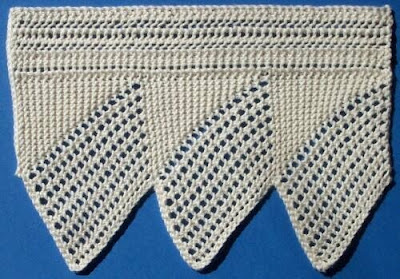Variations of the pattern can be found in many modern day texts. Knitting Counterpanes: Traditional Coverlet Patterns for Contemporary Knitters by Mary Walker Phillips, for example, includes "Braided Leaf Insert." While designed as a panel, the pattern is essentially the same as Vine Tidy (more about that "tidy" in a moment), the only difference being that the two vines at the center of the insertion, while flanked by trellises on the right and left, are separated from one another by a single eyelet.
Note the scalloped cast-on edge. Worked without a border, the Vine Tidy pattern also has this feature.
I have charted the pattern as it would appear in a knitting stitch dictionary, but the instructions in the sample book were written to create a specific household article, the tidy. In some Victorian sources, the tidy is a receptacle of some kind-- a box to set in the bathroom and hold toiletries, a bag to hang from a doorknob and organize mail. Here, however, the tidy is a square or rectangular doily (antimacassar, dresser scarf, placemat, etc.) knit back and forth rather than from the center.
Worked across 89 stitches and featuring three repeats of the vine pattern, the tidy includes a stockingnet border, a curious selection given the tendency for the ends to curl up and the selvedges to curl under, as evidenced in the photo. A border of garter or seed stitch would have been a better choice. My sample was knit in fingering weight cotton on 2.25mm needles. With 16 pattern repeats, the finished piece blocked to 11¼" X 17½".
In the sample book Vine Tidy was hand-written by our anonymous knitter with no attribution, but I couldn't help but notice that it is identical in every respect (same width, same border, same three vines, everything) to a pattern found in my favorite book in my knitted lace library, Fancy Work Recreations: A Complete Guide to Knitting, Crochet, and Home Adornment published in 1884 (there's that date again!) by Buckeye Publishing Co., Minneapolis, and written by Eva Marie Niles, shown below in the frontispiece.


Ms. Niles must have been a lace knitter first and foremost. Although the text covers a wide variety of needlework including crochet, patchwork, embroidery, drawn thread, macramé, darned lace and netting, not to mention crafts such as skeletonizing leaves, splatter pictures, leather work, brass repoussé and others, fully a third of the 433-page work is devoted to knitted designs, mostly lace. An explanatory note at the back of the book cites the Housekeeper, Peterson's Magazine and the New York Tribune as sources for some of the instructions, but adds that "a greater part of the knitting and crochet is original with the author."
In this period the technology of reproducing photographs in books and newspapers was advancing, although online sources disagree on the exact date the first of such illustrations appeared. Photographic images in publications may have made their debut a few years before or shortly after Fancy Work Recreations, but whatever the fact of the matter, the process surely must have remained prohibitively expensive for some years, and drawings and etchings continued to be the most common illustrations in needlework books and magazines. The image accompanying Ms. Niles' "Vine Tidy" pattern shows a detail of the design. The swatch is presented with the cast-on edge at the top, in contrast to current practice where stitch pattern photos reflect the conventions of charting, with row 1 at the bottom.
Up next: Untitled Edging
















































